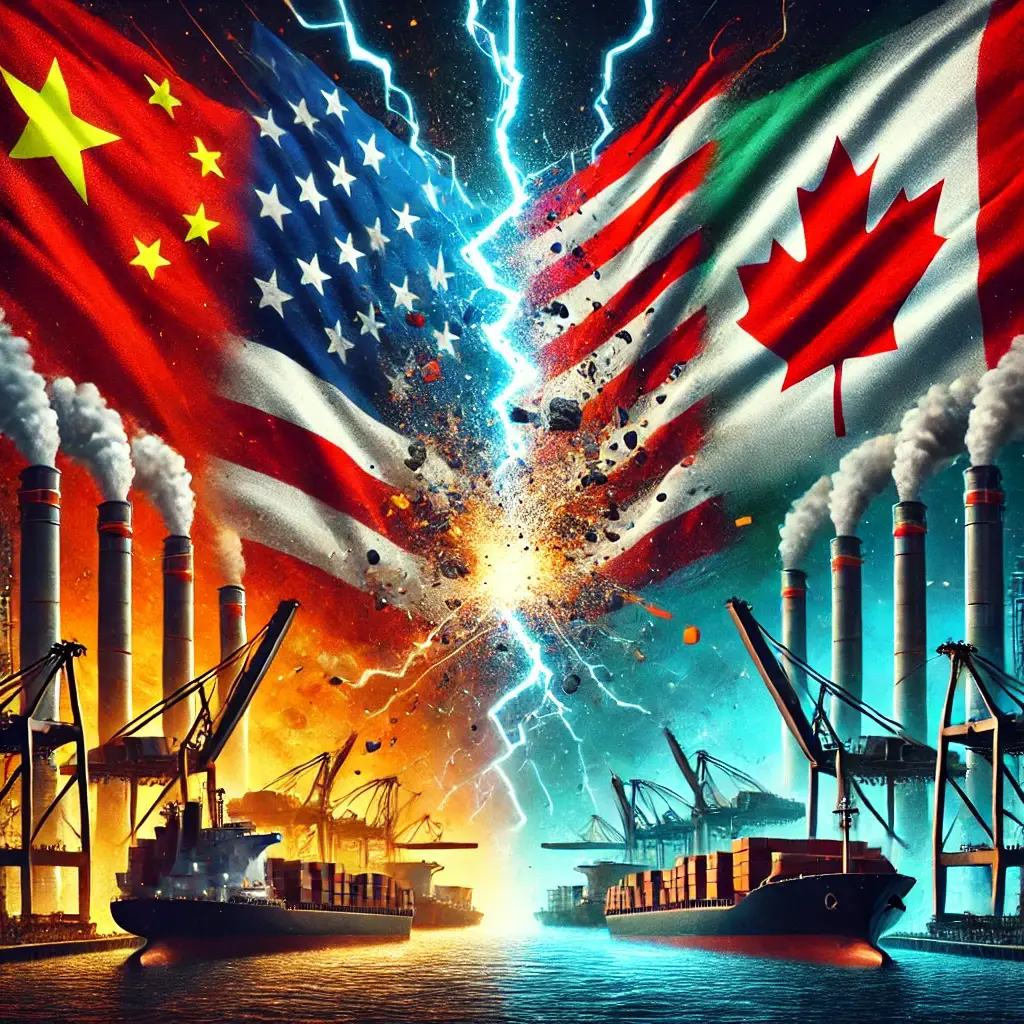Will Trump’s New Tariffs Trigger a Stock Market Meltdown?

Not even a quarter into the new year, and we’re already off to a wild start—political chaos, shocking NBA trades, Mahomes falling short in the Super Bowl, and now a looming global trade war.
Unless you’re living in a cave, you’re aware that U.S. President Donald Trump has announced a 25% tariff on all steel and aluminum imports, a 10% tariff on Chinese goods, reciprocal tariffs, and proposed 25% tariffs on Mexican & Canadian imports.
Sound familiar? That’s because we’ve been here before. Welcome to “Groundhog Day.” The 2018–2019 trade war sent shockwaves through the stock market, raised business costs, and reshaped global trade. By May of 2019 it had cost the market $5 trillion dollars. Now, with a new round of tariffs here and potentially more on the way, what can investors expect this time around?
Let’s break down how past tariffs impacted the economy, which industries will feel the most pressure, and how smart investors can position themselves for potential opportunities. Keep in mind, tariffs alone won’t make or break a stock. The market is influenced by many factors, and it’s important to take a big picture approach when investing.
How did the Market Perform During the 2018-19 Trade War
Trump’s last round of tariffs led to market volatility, corporate profit declines, and supply chain disruptions. But how did the market perform?
S&P 500 Performance:
- 2018: The S&P 500 fell sharply multiple times, including a near 20% plunge in Q4, largely due to trade war fears and Fed rate hikes. The year ended with a -6.24% return, its worst since 2008.
- 2019: The market rebounded in a big way, finishing up 28.9% for the year. This was fueled by Federal Reserve rate cuts, a partial trade deal with China, and the U.S. lifting tariffs on steel and aluminum imports from Canada and Mexico as part of the United States-Mexico-Canada Agreement (USMCA).
Manufacturers & Tech Companies:
- Automakers like Ford & GM took a hit due to higher steel and aluminum costs.
- Apple was hit by China’s retaliatory tariffs and supply chain issues, leading to a 5.39% decline in 2018. However, the company bounced back with an impressive 89% return in 2019 after trade tensions eased.
- Tesla faced significant tariffs on imported parts but still outperformed the S&P 500 with a 6.89% return in 2018 and gained 25.7% in 2019.
2018-2019 Trade War Winners & Losers
✅ Winners:
- U.S. Steel & Aluminum Companies – Companies like Nucor (NUE) and U.S. Steel (X) benefited from reduced foreign competition.
- Defense Stocks – Companies like Lockheed Martin (LMT) and Northrop Grumman (NOC) benefited as military spending ramped up during this period. Both stocks were down in 2018 but rebounded in 2019, posting returns of over 45%.
❌ Losers:
- Automakers – Ford (F) and General Motors (GM) struggled with higher steel and aluminum costs, which are crucial to vehicle manufacturing. Ford’s stock tanked 38% in 2018, while GM was down about 15%.
- Retailers & Tech Stocks – Retailers like Walmart (WMT) and Target (TGT) suffered from rising costs on imported goods, making it more expensive to stock their shelves. Chipmakers like Nvidia (NVDA) and AMD were hit by supply chain disruptions and weak Chinese demand.
| Company | 2018 Return (%) | 2019 Return (%) |
|---|---|---|
| S&P 500 | -6.24 | 28.88 |
| Nucor (NUE) | -18.56 | 10.9+ |
| U.S. Steel (X) | -48.43 | -31.28 |
| Lockheed Martin (LMT) | -0.58 | 48.71 |
| Tesla (TSLA) | 6.89 | 25.7 |
| Ford (F) | -38.1 | 17.41 |
| Apple (AAPL) | -5.39 | 88.96 |
| Nvidia (NVDA) | -30.83 | 76.93 |
| AMD (AMD) | 79.6 | 148.6 |
The term winners and losers in this context refers only to the impact tariffs had on these businesses not their overall financial performance or health that year. Some companies, like AMD, thrived in 2018 with a 79% gain despite supply chain issues, while U.S. Steel struggled despite reduced competition. This goes to show that tariffs alone don’t dictate stock performance, other economic factors play a significant role.
How New Tariffs Could Impact the Stock Market in 2025
History tends to repeat itself, and if Trump follows through on his tariff plan long term, we can expect many of the same consequences we saw in 2018–2019 to play out again in 2025.
- Higher Prices: Tariffs act as a tax on businesses, which means higher costs for consumers. Expect more expensive cars (Ford, GM, Tesla) due to higher steel and aluminum costs and supply chain disruptions.
- Tech & AI Demand at Risk: Companies like Apple, Nvidia, and AMD could face supply chain delays and rising component costs due to new tariffs on Chinese imports, potentially sinking the stock market.
- Retailers (Walmart, Target, Costco) may raise prices to offset increased import costs, putting additional strain on consumers.
- Produce & Finance: If tariffs extend to Mexico and Canada beyond steel & aluminum, expect agriculture (corn, soybeans, and meat exports) and banking (JPMorgan, Bank of America) to feel the pressure due to retaliatory measures and trade disruptions.

Investment Strategy: How to Navigate a Trade War Market
The most important thing to do if a trade war breaks out, remain calm. Take a step back, watch how the market reacts, and assess your situation accordingly. Knee-jerk reactions rarely lead to good investment decisions.
1. Look for Buying Opportunities in Strong Stocks
- Tech stocks like Nvidia (NVDA), Apple (AAPL), and Microsoft (MSFT) may face short-term volatility but remain dominant players.
- Long-term investors should view tariff-related selloffs as an opportunity to buy quality stocks at a discount. Remember, Apple dropped over 5% in 2018 but rebounded with an 89% return in 2019—proving that strong companies tend to bounce back.
2. Don’t Panic Sell
- Panic selling is one of the worst mistakes you can make. If you’re investing in strong companies with a long-term mindset, there’s almost never a reason to dump your shares out of fear.
- Selling at the wrong time can cost you. Imagine dumping Apple in 2018 when it was down just 5%, only to watch it rocket up 89% in 2019. You’d have locked in losses and missed out on one of its best years.
Final Thoughts: Stay Focused, Stay Strategic
As of now, the market remains strong, and many analysts and business leaders believe Trump’s tariff threats are more of a negotiation tactic than a concrete policy shift. Whether that holds true in the coming months remains to be seen. But if a full-blown trade war does break out, expect increased market volatility—something we’ve seen before.
The most important thing? Don’t panic. Market uncertainty creates short-term noise but long-term opportunities for those who stay patient and strategic.
✔ Stick with strong companies that can weather economic turbulence.
✔ View market dips as buying opportunities instead of reacting emotionally.
✔ Keep an eye on the Fed and macroeconomic trends that could influence investment decisions.
At the end of the day, smart investors stay the course. History has shown that those with a long-term mindset ultimately come out ahead.
Want more insights? Check out my Top Money Moves for 2025 for other ways to stay ahead of the curve.
New to investing? Subscribe below and get free access to my e-book, “The Ultimate Beginner’s Guide to Buying Your First Stock.”